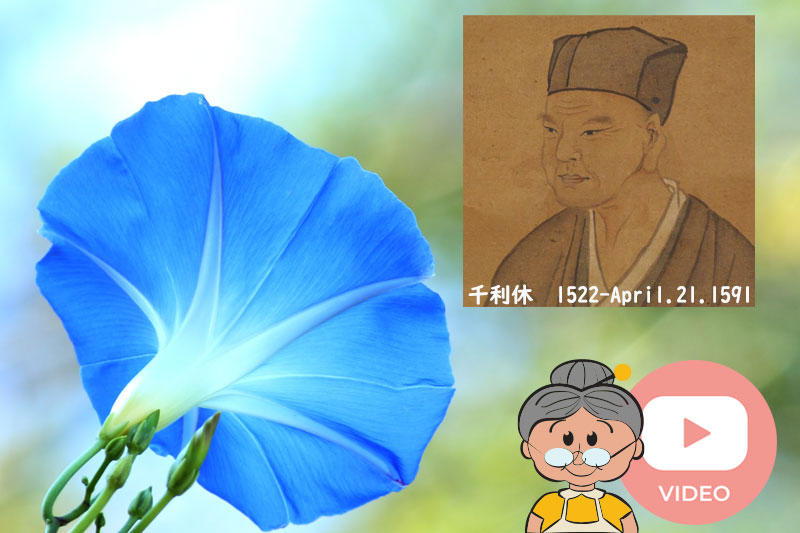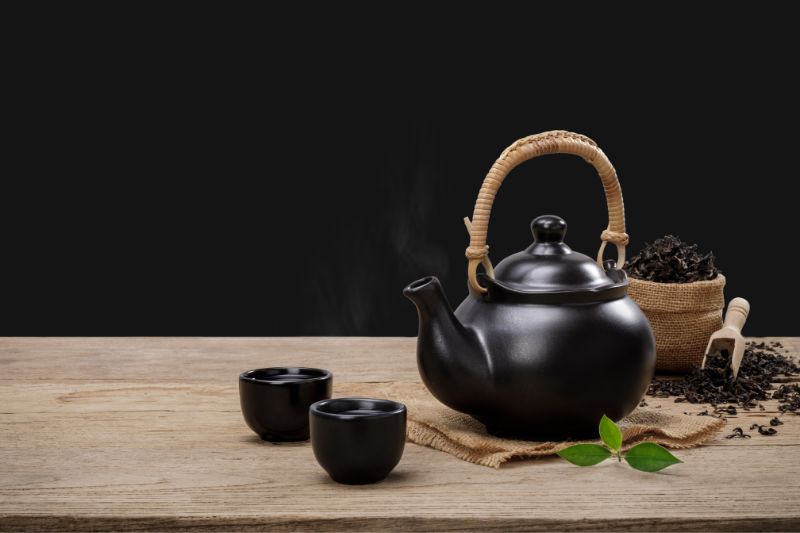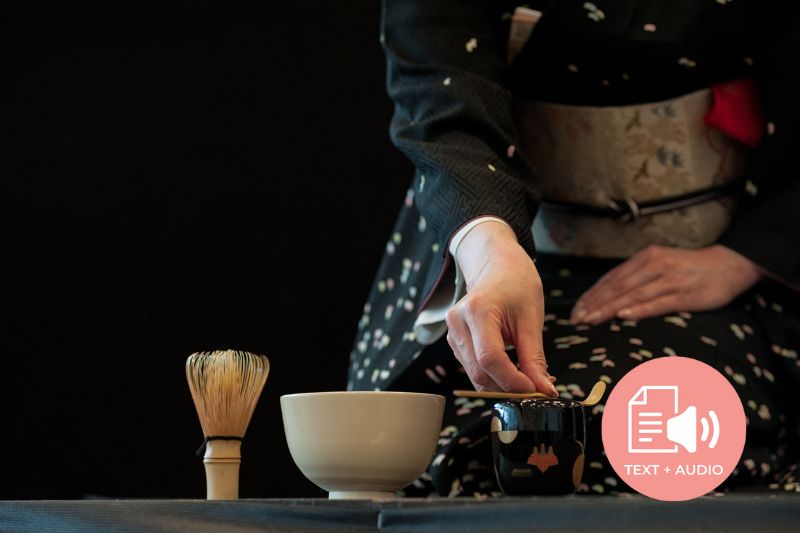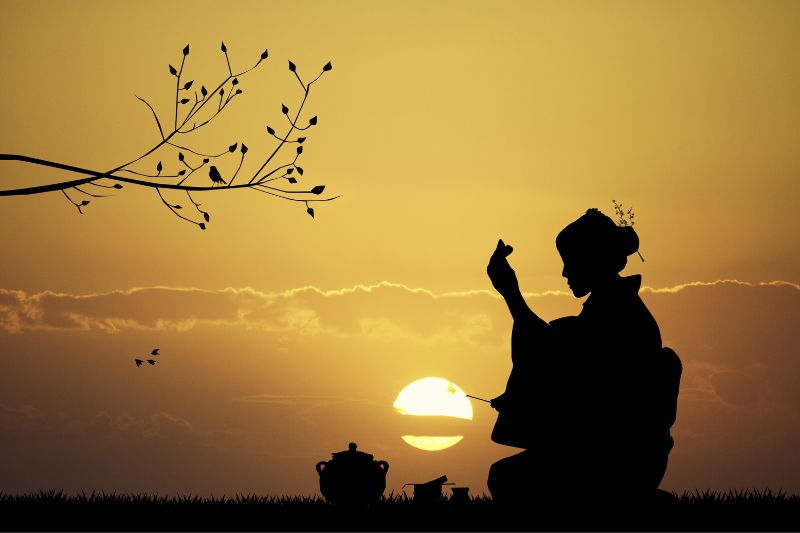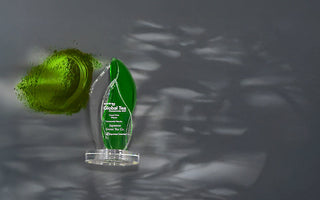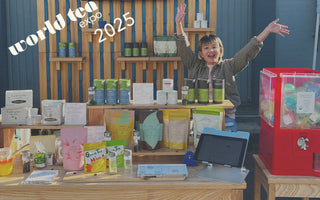This year, we decided to release a limited-edition packaging for our tea bag samples inspired by Katsushika Hokusai's most famous piece of art, The Great Wave off Kanagawa, from his incredible series Thirty-Six Views of Mount Fuji. (You can get your sample of this special edition here while stocks last!)
You might want to know why we specifically chose to create a modernized version of Hokusai's art - and many of you may be wondering who this famous Japanese artist is in the first place. No doubt you have seen this image before:

If this is your first time seeing it, we are happy to have shown it to you! This single image has imprinted itself into the minds of people around the globe as a quintessential piece of Japanese art akin to Leonardo Davinci’s Mona Lisa in its importance and recognizability. And we’re not the only ones in love with this picture; the Japanese government has begun integrating this artwork into the Japanese currency.
The New 1000 Yen Note

It was undoubtedly chosen not only for its cultural significance, but also because the intricacies of his work would make it very difficult for criminals to create forgeries. You can learn more about the other anti-counterfeit technology they use for this new banknote on the National Printing Bureau (NPB) website — it’s worth checking out. There is an interactive note you can look at and a video displaying the new hologram feature!
Hokusai Introduced to Japanese Passports
The NPB aren't the only ones utilizing Hokusai’s art to increase security. Since 2020, all Japanese passports feature multiple works from his Thirty-Six Views of Mount Fuji series. The ten-year passport has 24 images, and the five-year passport has 16. Japan already had one of the most powerful passports in the world, and now they might have the most stylish.


Hokusai, the Young Artist
Hokusai was born in 1760 in Edo (now named Tokyo), Japan, and was first named Tokitaro (he would change his name some thirty times in his life, as was the fashion at the time for Japanese artists). The exact date of his birth isn't known, but it is thought to be sometime in or around October. This was around the middle of the Edo period when Japan followed strict isolationist policies - no Japanese were allowed to leave Japan, and no foreigners were allowed to enter. Hokusai became one of the defining artists of this period.

An Intensive Education
It is said that Hokusai's father began teaching him to paint at the age of 6. At the age of 12, he began working at a bookshop/library, and by 14, he was working as an apprentice woodcarver. Finally, at the age of 18, he was accepted as a student into Katsukawa Shunshō's art studio, where the discipline was focused on a school of art known as Ukiyo-e.
This education set Hokusai on an artistic path that he followed for the next 70 years of his life until his death.
Ukiyo-e, Japan’s Fast Art
You may have first assumed that The Great Wave off Kanagawa is a big painting sitting somewhere in a museum in Japan. However, it is not a painting exactly as you may think - nor a one-and-only art piece. It is a product of Ukiyo-e, Japanese woodblock prints. Indeed, it is estimated that some 8,000 copies were made of The Great Wave off Kanagawa. Today, it is estimated that around 100 copies still exist.
Edo Period Extravagance
Ukiyo-e was aimed at the ordinary people of Japan. Interestingly, tea masters played a pivotal role in supporting Ukiyo-e artists like Hokusai. These connoisseurs often commissioned artworks to enhance the ambiance of their tea rooms, combining visual artistry with the meditative atmosphere of tea ceremonies. This unique patronage offered artists like Hokusai opportunities to explore themes of tranquility and reflection in their works, such as in Tea House at Koishikawa After Snowfall. Such collaborations not only enriched Hokusai’s portfolio but also underscored tea’s cultural significance during the Edo period.Typically, it depicted Kabuki theater actors, courtesans, sumo wrestlers, and geisha. The stability of the Edo period gave rise to a wealthy merchant class that used their newfound wealth to partake in the nightlife found in the big cities of Japan, and spent much of their money on fine goods and entertainment. Hence, the name "Ukiyo-e" - meaning something like "The Floating World," referred to this lavish lifestyle.
Art for the Masses
This form of art became incredibly popular. It is stunning, and as the process became more refined, the colors became ever more vibrant and impressive. Along with its aesthetic appeal, Ukiyo-e was inexpensive and readily available. It could be purchased cheaply as single sheets or in books and was often a souvenir for travelers. It is certainly a far cry from today, as a copy of The Great Wave off Kanagawa was sold in 2023 for nearly 2.8 million US dollars!
An Intensive Process
However, despite being an "easy" art form for the time, it was incredibly labor intensive. Most prints were made by a team of people. First, the design had to be drawn, then carved, then printed, and finally colored. They had to mass produce these prints, which weren't profitable until a few thousand had been sold. You can see what this process looks like in the video below, from the Utah Museum of Fine Arts:
Hokusai’s ingenuity extended beyond traditional techniques. Anecdotes recount his participation in a painting competition where he used an unconventional method to depict falling leaves: he dipped a chicken’s feet in ink and let it walk across the canvas, representing maple leaves floating on the Tatsuta River. This playful yet inventive approach not only entertained audiences but also showcased Hokusai’s ability to reinterpret everyday objects into artistic statements—a quality that parallels the transformative nature of the tea ceremony.
A Glimpse of Tea Culture in the Edo Period
Ukiyo-e was one of the most popular art forms of the time; there were likely hundreds of artists producing such works during the Edo Period. So, it begs the question, what was so special about Hokusai?
And better yet, what does his art tell us about Japanese tea in the Edo period? As it turns out, quite a lot!
Hokusai’s depictions of tea culture extend beyond their visual appeal, revealing philosophical undertones rooted in Zen Buddhism. Tea ceremonies during the Edo period emphasized simplicity, mindfulness, and impermanence—concepts that align seamlessly with Hokusai’s artistic philosophy. In Fuji from the Katakura Tea Fields, for example, the expansive tea fields symbolize harmony between human labor and the natural world, mirroring the meditative spirit of the tea ceremony.
Hokusai’s works, particularly those featuring tea culture, reflect the Zen Buddhist concept of wabi-sabi—the appreciation of imperfection and transience. The serene landscapes and humble tea-drinking scenes in his art suggest a reverence for the fleeting beauty of life, much like the ephemeral nature of tea ceremonies. His meticulous attention to detail in prints like Morning After a Snowfall evokes a sense of tranquility that aligns with the introspective nature of tea rituals.
Additionally, tea houses in Edo were not just places for refreshment but also cultural hubs that displayed Ukiyo-e art. These spaces likely inspired Hokusai’s detailed portrayal of tea-picking and tea-drinking scenes, which were integral to both commerce and social life.
Hokusai’s New Perspective
Like the other Ukiyo-e artists of his time, Hokusai created images on subjects such as kabuki theater and geisha. However, in the years leading up to the 19th century, he drew inspiration from French and Dutch engravings that changed the focus of his art completely. Instead, he began to create prints that depicted landscapes and everyday life in Japan. This was when his art became revolutionary for its time. Here, we can see some examples of Japanese tea culture as depicted by Hokusai.
Fuji from the Katakura Tea Fields

In Fuji from the Katakura Tea Fields, Hokusai gives us a beautiful view of what Japanese tea cultivation may have looked like at the time. This place is close to the region where we grow our tea today! Our tea is cultivated a mere 50 kilometers (31 miles) from this area. It is clear from this illustration that this has been prime land for tea farming for centuries. We can see women picking the tea and men packing it into baskets and carrying it into storage. The fields trail off far into the distance. No doubt, Japan's tea industry was enormous even then.
Hokusai’s choice to highlight the labor of tea workers offers a unique perspective on Edo-period society. By focusing on the women and men harvesting tea leaves, he captures the collaborative human effort behind Japan’s iconic beverage. These scenes not only celebrate the beauty of tea cultivation but also serve as a tribute to the workers whose livelihoods depended on the land. This focus adds a layer of realism to his otherwise idyllic depictions.
Tea House at Koishikawa. The Morning After a Snowfall.

This Winter landscape depicts patrons at a tea house after a fresh snowfall. Koishikawa, now located in modern-day Tokyo, is a place renowned both in Hokusai's time and now as having some of the most beautiful gardens in Japan. People who are likely travelers are shown relaxing and observing nature. The Japanese have always connected tea drinking with both socializing and contemplation. Hokusai’s works often present tea as a unifying symbol. In Yoshida on the Tokaido, for instance, teahouses are depicted as sanctuaries for travelers along the bustling trade route. These establishments embodied hospitality and provided spaces for rest and reflection, much like the tea ceremony itself. By integrating such scenes into his art, Hokusai emphasized the cultural and social importance of tea in fostering community and introspection.
You can read more about this aspect of Japanese tea culture in our article about Green Tea Ceremonies.
Yoshida on the Tokaido

In Yoshida on the Tokaido, we can again see the role the teahouses played during this time of booming trade and travel. They were places where people could rest and refresh themselves. Tokaido was one of the main travel routes into and out of Tokyo. While not much of the original path remains, it is still the most traveled road in all of Japan. It leads from Osaka to Kyoto, Kyoto to Nagoya, and finally to Tokyo.
Woman Preparing Tea Around the Fire-Holder

Even in Hokusai's slightly earlier works, tea is an important subject. This piece from 1816 depicts women preparing tea, and is accompanied by poetry, written by Torintei Tokuma and Rokuzotei. It reads:
東隣亭徳馬 きのふまてにない手桶のあけほのにひとよこし茶もけふの若水
Yesterday, the hand bucket was empty, but this morning, fresh water for tea is ready.
六歳亭宝馬 神垣や朝日のうつる亀井戸のそこまて匂ふふかき梅か香
The sacred fence and the morning sunlight reflect in the turtle well, and the deep fragrance of plum blossoms reaches all the way to the bottom.
七十四翁 談洲楼焉馬 かはらすに福茶のなかの寿老人まめにさんせう梅干おやち
In the fortunate tea, the old man of longevity carefully adds three pickled plums.
Hokusai’s Reality
Of course, we should never take art too literally. Oscar Wilde said it best:
“Now, do you really imagine that the Japanese people, as they are presented to us in art, have any existence? If you do, you have never understood Japanese art at all. The Japanese people are the deliberate self-conscious creation of certain individual artists. If you set a picture by Hokusai, or Hokkei, or any of the great native painters, beside a real Japanese gentleman or lady, you will see that there is not the slightest resemblance between them. The actual people who live in Japan are not unlike the general run of English people; that is to say, they are extremely commonplace, and have nothing curious or extraordinary about them. In fact the whole of Japan is a pure invention. There is no such country, there are no such people.”
Oscar Wilde, The Decay of Lying - An Observation, 1891
Hey, wait a minute! That sounds pretty harsh, Japanese people definitely exist!
Don’t get upset - what Wilde really means is that we should not take the version of things we see in Japanese art too seriously. Instead, it is best to interpret such things as Hokusai's construction of reality and his artistic interpretation of Japan and Japanese culture during the Edo period. Japanese art, especially from this time, carries its own depth, philosophy, and religious significance, making it difficult for outsiders to appreciate or even fully comprehend what is beyond the beautifully presented surface.
So, What Can We Learn from Hokusai's Depictions of Tea?
The fact that Hokusai decided to create images of teahouses and tea drinking (for his almost exclusively Japanese audience) gives us an idea of how culturally significant tea was, and still is. Tea represents happiness, peace, relaxation, and camaraderie in his artwork. It signifies increasing travel and a booming economy. It also has meditative and religious significance, especially when paired with the revered Mount Fuji, which is an incredibly important symbol in both Shintoism and Buddhism in Japan.
An Inspiration to the World
We often think of great artists and musicians as having a prime period in their younger or middle years. Hokusai, however, began to achieve his most remarkable feats far later. He was around 70 years old when he made The Great Wave off Kanagawa. Most of his well-known prints are from around this same time period after the 1830s. However, unfortunately his popularity began to wane some years after this as new artists started to forge their careers. But isn't this how it always goes?
A True Master Until the End
It is thought that Hokusai created over 30,000 different works in his time. Toward the end of his life, he was still striving for artistic perfection and reportedly said on his deathbed, “If heaven will afford me five more years of life, then I'll manage to become a true artist.” He passed away in 1849 at the age of 88.
Renewed Popularity in Europe
Just a few years after his death, in 1853, Japan would finally open its borders and begin freely trading with the rest of the world. Around this time, Hokusai's art began to have a considerable impact on European impressionists. His works significantly influenced Vincent van Gogh, an avid collector of Japanese prints, and other artists such as Claude Monet.
Below is a cover of the special double-issue of Praris Illustre that appeared in May 1886, and it is said that van Gogh was so impressed by this cover that he used it to trace the figure, and went on to create one of his largest and ambitious copies of Japanese prints, "Japonaiserie Oiran."

The Japan Special Issue of “Paris Illustre”

However, Hokusai`s impact was not limited to the visual arts - the cover of the printed score for the French composer, Claude Debussy's La Mer from 1905, features “The Great Wave off Kanagawa.”

"La Mer: Three Symphonic Sketches" by Claude Debussy, 1905
In addition to this, “The Great Wave off Kanagawa” is said to have even influenced “The Wave” and other works in the series by the French artist, Gustave Courbert. Furthermore, the painter and designer, Henri Riviere, is believed to have replaced the Eiffel Tower with Mount Fuji in the Thirty-six Views of Mount Fuji when he was producing various lithographs of the Eiffel Tower, while the iconic tower was still under construction, as he spoke of the composition and deformed expressions of Hokusai. Believe it or not, the collection of these lithographs were eventually titled – The Thirty-Six Views of the Eiffel Tower! This is said to be one of the greatest examples of Japonisme, and it is no wonder that Riviere was called the uikyo-e artist of Paris. Paris at the end of the 19th century was greatly influenced by Japonism, and it was none other than Hokusai who laid the groundwork for this.

Today, Hokusai is Still Everywhere
Hokusai is as relevant and beloved as ever even today. It isn't just high-brow painters who have been touched by his astounding images - you can find his work just about anywhere in the world. Throughout time, his art has proven to awe both the aristocracy and the average person. Just recently, a tribute to his art was found in one of the most strange places . . .
The Parisian Catacombs
Paris is a very old city, indeed. Underneath it are hundreds of tunnels - every single street in Paris has a sewer system that’s almost as big as every street. There is essentially a city underneath the city! These sewers are called Les Egouts, and you can visit a portion of them in a similarly named museum (just be sure to breathe through your mouth!) Additionally there are many catacombs and other old tunnels that some daring people enjoy exploring. A Japanese journalist named Maruyama Gonzales discovered something intriguing inside one such tunnel.
A Piece of Japan Deep Under Paris
While exploring the tunnels underneath Paris, Maruyama bumped into some other people. At first, he was nervous, not knowing if they were dangerous. Thankfully, they were just explorers like him and offered to take him to "the beach" of the underground. Curious, he agreed and followed them through the dark. He had no idea what he was about to discover.
Discovering the Underground “Beach”
Finally, after walking for some time and wriggling through wall gaps, they came to "the beach." It was a room with a low ceiling full of graffiti, but what immediately stood out to Maruyama was an enormous mural featuring The Great Wave off Kanagawa! Almost two hundred years later, Hokusai's print still infects artists from every discipline with its unforgettable composition. You can read more about it in the original Japanese source here.

Today, Hokusai’s influence continues to shape the tea industry. His iconic prints inspire modern branding, with limited-edition teabags and packaging featuring reimaginations of his work. This blending of tradition and modernity not only honors Hokusai’s legacy but also introduces his art to a global audience in innovative ways. Additionally, his depictions of tea culture serve as educational tools, helping museums and brands alike convey the richness of Japanese history and aesthetics.
Beyond branding, Hokusai’s art has influenced contemporary Japanese tea ceremonies, inspiring tea masters to incorporate Ukiyo-e motifs into their practice. For example, some modern tea rooms now use Hokusai-themed scrolls or ceramics, blending traditional rituals with his timeless aesthetics. This integration reinforces the idea that Hokusai’s vision continues to shape how tea culture is experienced today.

The Largest Ever Hokusai Exhibition in 2014
The largest ever Hokusai exhibition was held at Paris in 2014, and had put the place into craze. Celebrating the bicentennial of the publication of the first volume of 『北斎漫画』 (“Hokusai Manga”), the exhibition was held at Galeries Nationales du Grand Palais, which had been built as the main hall for the 1900 Paris Expo. Beginning with “The Great Wave off Kanagawa”, some 700 works of art and documents including 肉筆画 (nikuhitsuga, a genre of brush drawn paintings), rough sketches, and 錦絵 (nishiki-e, polychrome woodblock prints) were displayed in the 1,000-meter² exhibition hall. Among them were even works that had never been exhibited in Japan.

It is said that 350,000 people attended the exhibition, and the Hokusai fans who had awaited for the opening formed long lines daily outside the Hokusai Exhibition. This not only shows how Hokusai’s popularity still remains strong today, but how he still continues to gain new fans.
It won`t be an overstatement to say that Hokusai could be called the father of Japonism and Art Nouveau. He is definitely one of the most famous Japanese artists in the world, who has gained high popularity even in France.
Amusing Stories of Hokusai
It is safe to say by now that Hokusai has reached legendary status. As such, there are many entertaining stories about him (some more believable than others.)
Here are two such tales to be taken with a grain of salt.
Unorthodox Methods
He was once invited by the shogun, Tokugawa Ienari, to compete against another artist to see who was best. It is said that Hokusai painted curved blue lines on some paper, dipped a chicken's feet into red paint, and chased it across the paper. He said that it was a landscape of the Tatsuta River with red maple leaves floating in it, and won the competition. Indeed, he created a print of this river in the 1830s, but we will let you decide if the legend is true.

Struck by Lightning
Another story is that in 1810, Hokusai was struck by lightning. He survived, but this caused him to change the direction of his art, and even made him move to a new city. Although this story is often mentioned in various articles and news sources, it is likely just a myth, albeit a rather funny one.
What Hokusai Means to Us
At Dream of Japan, we always strive to present authentic Japanese culture to people, whether that’s through our articles or our products. So, in deciding what piece of art would represent Japan best, it quickly became clear to us that The Great Wave off Kanagawa was the right choice. It was part of the wave of culture and tradition that connected a once-isolated Japan to the world - a connection we want to keep strong. Hokusai's dedicated nature, terrific imagination, and an eye for constant improvement is precisely how we must strive to be.
Get Free Bonus Books

Sign up for free to the Green Tea Club to get advice and exclusive articles about how to choose Japanese Tea, and tips, tricks, and recipes for enjoying Japanese tea.
About the author
Kei Nishida
Author, CEO Dream of Japan
Certification: PMP, BS in Computer Science
Education: Western Washington University
Kei Nishida is a passionate Japanese green tea connoisseur, writer, and the founder and CEO of Japanese Green Tea Co., a Dream of Japan Company.
Driven by a deep desire to share the rich flavors of his homeland, he established the only company that sources premium tea grown in nutrient-rich sugarcane soil—earning multiple Global Tea Champion awards.
Expanding his mission of introducing Japan’s finest to the world, Kei pioneered the launch of the first-ever Sumiyaki charcoal-roasted coffee through Japanese Coffee Co. He also brought the artistry of traditional Japanese craftsmanship to the global market by making katana-style handmade knives—crafted by a renowned katana maker—available outside Japan for the first time through Japanese Knife Co.
Kei’s journey continues as he uncovers and shares Japan’s hidden treasures with the world.
Learn more about Kei



